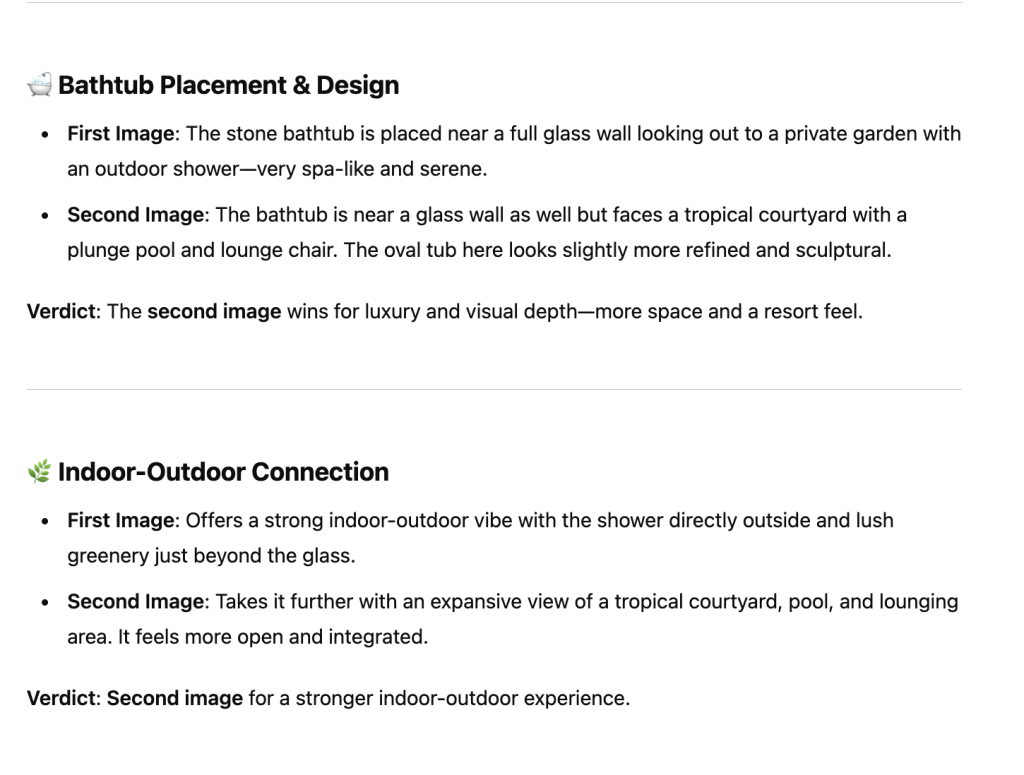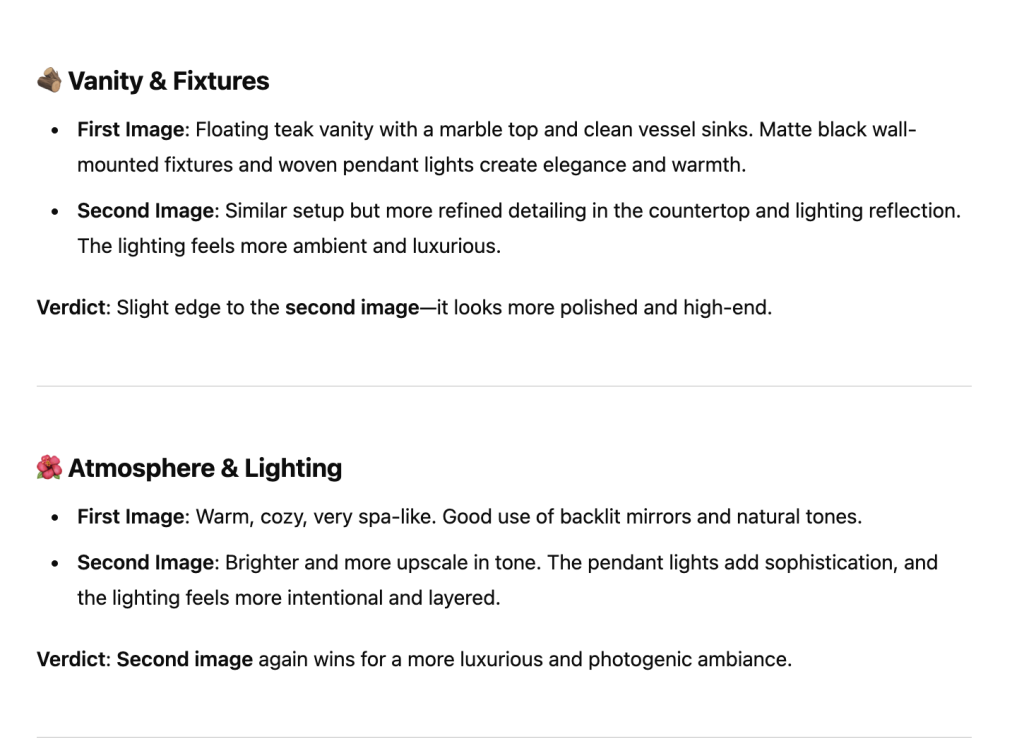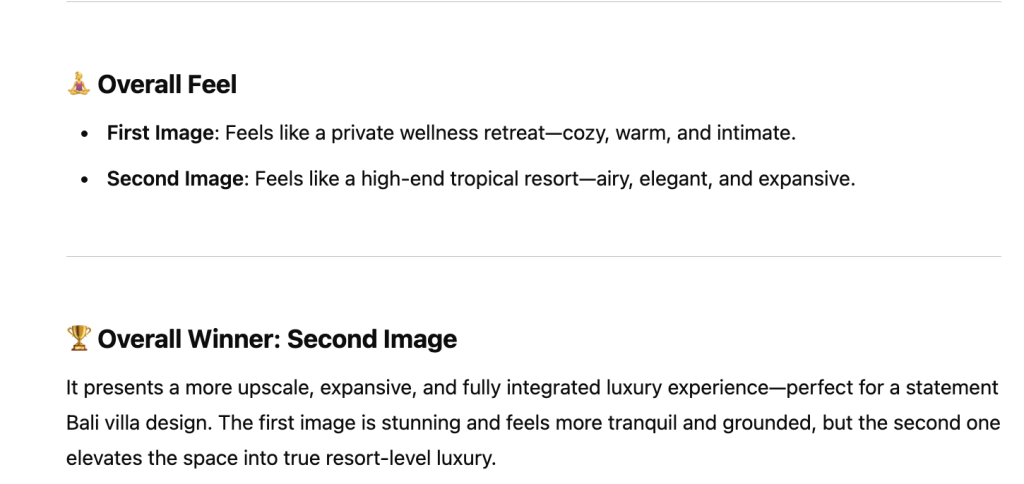
In the ever-evolving landscape of artificial intelligence, the past few years have been dominated by the rise of general-purpose models like OpenAI’s ChatGPT and Google’s Gemini. These large language models have dazzled us with their ability to summarize complex papers, write fluent code, brainstorm creative content, and carry on eerily human-like conversations. And with OpenAI announcing awe-inspiring image generation in their ChatGPT 4o model, the stakes went even higher. But as AI begins to stretch into real-world industries, such as real estate, a new trend is taking shape: the verticalization of AI.
A recent experiment comparing two AI systems on a seemingly simple design task – creating a luxury washroom in a Bali villa – offers a striking glimpse into where this evolution is heading. On one side, ChatGPT 4o with their latest image generation capability. On the other, a relatively new entrant: GRAI, the world’s first contextual real estate AI advisor.
The prompt was identical for both:
“Design a luxury Bali villa washroom with a freestanding stone tub, tropical garden view, teak wood accents, marble counters, and soft ambient lighting.”
The results? The difference was undeniable.

Image generated by GRAI

Image generated by ChatGPT 4o
ChatGPT 4o produced a visually appealing render. It was imaginative, styled, and aesthetic in the way we’ve come to expect from AI image generators. But GRAI’s output went further. The image it produced didn’t just look good – it felt real and meant for real estate. The materials matched the climate. The layout reflected spatial logic. The lighting responded to architecture, not just art direction. The foliage wasn’t generic, but distinctly tropical. The scene didn’t evoke Pinterest; it resembled a brochure for a real villa.
This comparison, small as it may seem, encapsulates a massive shift in the AI ecosystem: the growing divide between generalist models and domain-native vertical models like for real estate. Interestingly, ChatGPT 4o itself rated GRAI’s image as better!




Why General AI Isn’t Always Enough
ChatGPT and Gemini are incredible tools. They represent the bleeding edge of language modeling, and their usefulness in tasks ranging from tutoring to translation is undeniable. But generality has its limits. Ask these systems to navigate the nuanced needs of a real estate project, and they can generate ideas – but not blueprints. They can brainstorm, but not build.
That’s where vertical AI platforms come in. Trained specifically on domain knowledge – whether that’s finance, medicine, or, in GRAI’s case, real estate and architecture – these models aren’t just intelligent. They’re contextually aware. In real estate AI, this distinction is crucial.
GRAI, for instance, doesn’t just interpret text prompts. It understands the realities of zoning, sunlight direction, regional building styles, materials like cedar or lava stone, and even plot-based constraints. It can design a villa on a sloped site in Uluwatu or generate a modern apartment floor plan for central London. This is AI that doesn’t just generate ideas – it generates answers.
The Vertical AI Advantage
The broader trend here mirrors one we’ve seen time and again in tech. General-purpose tools emerge first. Then, as use cases solidify, specialized tools outpace them. Salesforce didn’t win by being a better spreadsheet. It won by being a CRM that knew sales. Figma didn’t beat Photoshop by being more powerful – it won by being purpose-built for UI/UX.
AI is now entering that same phase. General-purpose models will remain foundational, but the future lies in AI that deeply understands your problem space.
In GRAI’s case, that means:
- Reacting to land plot dimensions and geography
- Generating realistic layouts and renderings
- Understanding regional regulations and design norms
- Giving investment-grade advice for real estate investors, developers and agents
And just like that, what was once “AI art” becomes something closer to AI architecture, especially in real estate.
Designing the Real World
The implications for real estate are massive. For architects, GRAI could replace hours of drafting and moodboarding with smart, client-ready visuals. As an investor, you can quickly validate feasibility and ROI. For homeowners, it unlocks personalized home planning without needing a full design team.
Most importantly, tools like GRAI democratize what was once expensive expertise. It gives the power of insight, visualization, and context to anyone with an internet connection. That’s not just a product – it’s a platform for global creativity.
The Battle Isn’t AI vs. AI. It’s Context vs. Generality.
The showdown between ChatGPT 4o and GRAI wasn’t about better images. It was about depth of understanding. One AI interpreted the words. The other understood the world those words live in.
As AI continues to expand into every industry, the winners won’t just be the smartest models. They’ll be the most situationally aware. The ones that aren’t just trained on everything, but fine-tuned for something.
In that light, GRAI as a real estate AI advisor isn’t just a cool design tool. It’s a preview of what comes next for every sector: law, finance, education, manufacturing, and beyond.
The age of vertical AI has arrived.
And if the Bali washroom test is anything to go by, it’s going to change everything.
GRAI is currently available for public use at internationalreal.estate. Limited free access, then subscription-based



